

The global demand for food is expected to increase in the coming decades, but global food production may not be able to keep pace with it. A study published in Nature journal in October showed a prevalent decline in cropping frequency (CF), crop caloric yield and caloric production.
CF refers to the number of crops cultivated per year on a given area of land. Crop caloric yield is the crop yield in calories produced per area.
There was a decline in the above three for warm areas in the study period of 1979-2018, resulting in an overall decline in the global average.
Warm regions — which already have a long growing season — might record lower CF due to the higher risk of crop failure caused by more frequent heat or drought stresses, the paper said.
These dynamics have been confirmed for the Brazilian corn–soyabean cropping system. Satellite observation in these regions suggested that CF was impacted by warming. The study was done by 10 researchers from the United States, China, France and Hong Kong.
India’s staple rice and wheat crops have been significantly impacted in the last two years due to climate change. This year, many farmers witnessed their usual cropping cycles getting disturbed. They could not take up timely sowing of the kharif crop due to the failure of monsoon rains.
Rains were delayed significantly in some areas. In such cases, farmers avoided the cropping season altogether to timely sow the next rabi crop. Meanwhile, the researchers also estimated lower declines or even smaller gains for cold areas per one degree Celsius of warming.
“Warmer temperature might be beneficial for increasing CF in cold areas, as the frost-free period expands and shortens single-crop growth duration,” it said.
For example, there are increases in CF in Canada, Scandinavian countries, Mongolia and Russia with above 1°C warming. However, the authors suggested that these increases are insufficient to fully offset the decline in warm and dry regions.
Irrigation effectively offsets the projected production loss, but irrigated areas have to be expanded by over five per cent in warm regions to fully offset climate-induced production losses by the 2050s.
These divergent conclusions support the need for holistic quantification of how climate warming influences global-scale CF to manage its impact on regional and global food security.